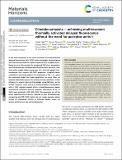Diindolocarbazole – achieving multiresonant thermally activated delayed fluorescence without the need for acceptor units
Abstract
In this work we present a new multi-resonance thermally activated delayed fluorescence (MR-TADF) emitter paradigm, demonstrating that the structure need not require the presence of acceptor atoms. Based on an in silico design, the compound DiICzMes4 possesses a red-shifted emission, enhanced photoluminescence quantum yield, and smaller singlet-triplet energy gap, ΔEST, than the parent indolocarbazole that induces MR-TADF properties. Coupled cluster calculations accurately predict the magnitude of the ΔEST when the optimized singlet and triplet geometries are used. Slow yet optically detectable reverse intersystem crossing contributes to low efficiency in organic light-emitting diodes using DiICzMes4 as the emitter. However, when used as a terminal emitter in combination with a TADF assistant dopant within a hyperfluorescence device architecture, maximum external quantum efficiencies of up to 16.5% were achieved at CIE (0.15, 0.11). This represents one of the bluest hyperfluorescent devices reported to date. Simultaneously, recognising that MR-TADF emitters do not require acceptor atoms reveals an unexplored frontier in materials design, where yet greater performance may yet be discovered.
Citation
Hall , D , Stavrou , K , Duda , E , Danos , A , Bagnich , S , Warriner , S , Slawin , A M Z , Beljonne , D , Köhler , A , Monkman , A , Olivier , Y & Zysman-Colman , E 2022 , ' Diindolocarbazole – achieving multiresonant thermally activated delayed fluorescence without the need for acceptor units ' , Materials Horizons , vol. Advance Article . https://doi.org/10.1039/d1mh01383a
Publication
Materials Horizons
Status
Peer reviewed
ISSN
2051-6347Type
Journal article
Description
The St Andrews team would like to thank the Leverhulme Trust (RPG-2016-047) for financial support. Computational resources have been provided by the Consortium des Équipements de Calcul Intensif (CÉCI), funded by the Fonds de la Recherche Scientifiques de Belgique (F. R. S.-FNRS) under Grant No. 2.5020.11, as well as the Tier-1 supercomputer of the Fédération Wallonie-Bruxelles, infrastructure funded by the Walloon Region under the grant agreement n1117545. We acknowledge support from the European Union's Horizon 2020 research and innovation programme under the ITN TADFlife (GA 812872). Y.O. acknowledges funding by the Fonds de la Recherche Scientifique-FNRS under Grant no. F.4534.21 (MIS-IMAGINE). D. B. is a FNRS Research Director. EZ-C is a Royal Society Leverhulme Trust Senior Research fellow (SRF\R1\201089).Collections
Items in the St Andrews Research Repository are protected by copyright, with all rights reserved, unless otherwise indicated.

